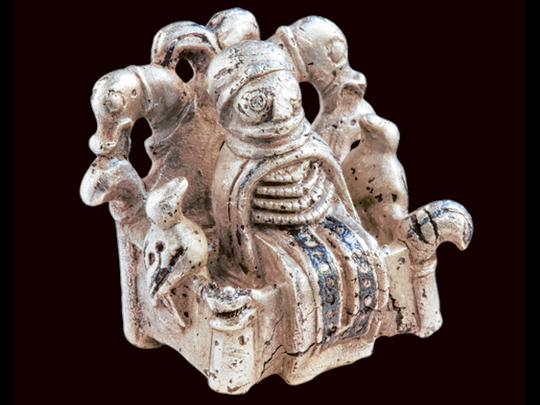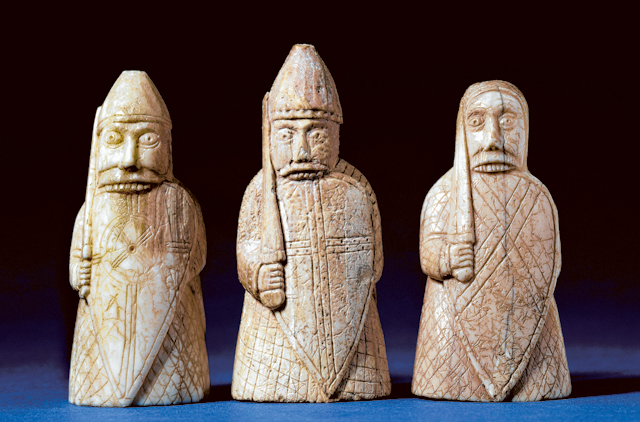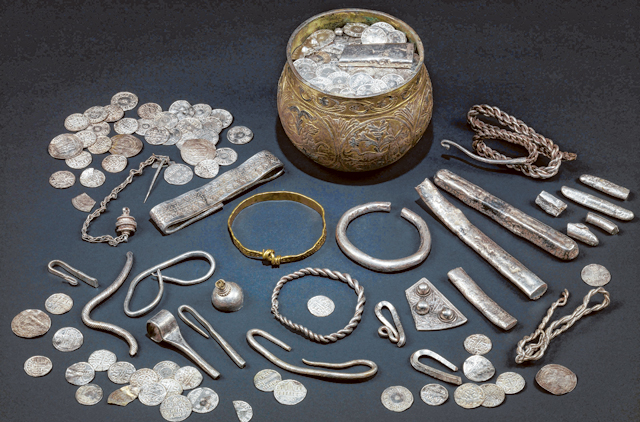
Everyone knows about the Vikings. Lawless, ruthless pagans sporting horned helmets who swept ashore in their long boats with their broadswords and axes, laying waste to the countryside, raping and pillaging.
An exhibition at London’s British Museum, “Vikings: life and legend”, challenges the myths cultivated over the centuries by medieval sagas, the romantic view of the 19th century and the Hollywood hype of blood and gore.
True, the Vikings lived by the sword but as their power grew between the 8th and mid-11th centuries they came to value trade as much as raids and became involved with far-off countries, exchanging cultures, developing skills in metal work, and even writing poetry and playing board games.
The word “Viking” comes from the Old Norse word, vikingr, which meant pirate or raider. They came from present-day Denmark, Norway and Sweden, living in farmsteads or settlements of little more than 100 people, based along the region’s myriad coves and inlets.
British Museum Curator Gareth Williams says: “The word Viking has come to be used as a label for a whole society and one which had an ethnic unity, but Scandinavia at the time was a fragmented and culturally complex society. Viking is a job description of pirates or raiders who were operating outside of society. You can say all Vikings were warriors but not all Scandinavians were Vikings.”
For the best part of three centuries the Vikings swaggered across the Atlantic, settling in Greenland and reaching North America and cruising down rivers in their shallow boats to Kiev in the Ukraine, the Byzantine capital Istanbul in the southeast, on to the Islamic Caliphate which stretched from central Asia to Baghdad, Jerusalem and along the Mediterranean coast to Morocco.
Their aim was to get rich with plunder and from the tributes paid to their conquering forces, and the key to their success were small marauding bands — often only 30 or so warriors — in fast, manoeuvrable ships.
Appropriately, their naval power is celebrated by the first object to be seen in the exhibition — a small brooch in copper from between 800-1050 shaped like a ship, with two dragon heads and a reefed sail.
But the undoubted show-stealer is the mighty “Roskilde 6” warship that dominates the entire hall of the museum’s new extension.
To reach it the visitor is taken past cases laden with hundreds of artefacts which unravel the show’s main themes. They trace the extent of the Vikings’ early travels and their interaction with other peoples that grew over time, and illustrate the consolidation of their power with examples of elaborate neck pieces and brooches.
Walk up a sloping corridor and into the new hall and there it is — the “Roskilde 6” — its majestic lines recreated by a curved steel frame which, strangely, adds to its fearsomeness.
While only 20 per cent of the original keel remains, the ship was one of eight found in the harbour of Roskilde, Denmark, in 1996 and brought to London in separate units. Built in about 1025, the ship would have been a veritable war machine — more than 37 metres long and propelled by 40 pairs of oarsmen, their prodigious axes and swords, long bows and steel-tipped arrows at the ready.
It might have been used by King Cnut, who ruled over large parts of Scandinavia and England, and as a chronicler of the day described the fleets he and Svein Forkbeard assembled in 1013 and 1016 to attack England: “So great also, was the ornamentation of the ships, that the eyes of the beholder were dazzled ... the flashing of arms shone in one place, in another the flame of suspended shields. Gold shone from the prows, silver also flashed ... so great as the magnificence of the fleet that if its lord had desired to conquer and people the ships alone would have terrified the enemy before the warriors whom they carried joined battle at all.”
Williams says: “It would have been terrifying to have it come at you from the sea as we’ve seen in films but to my mind it would be scarier to be walking along the heart of England in the countryside and suddenly be aware that a fleet of these is just quietly drifting past the hedge.
“They attacked Paris by sailing along the River Seine and that’s how they got to central Asia, by using the river system from the Baltic and to the Caspian and Black Sea.”
The oarsmen were also fighters. These self-propelling troop carriers became bigger and by the second half of the 9th century they were often in fleets of 30 or more ships. Originally the raiding parties numbered only about 30 warriors but by the time they were planning to invade England in AD865-878 various groups had banded together to make a force of thousands. The men travelled light — just the barest essentials and their weapons. On longer expeditions they might have a supply ship alongside.
As their global reach increased, so did their aspirations. The artefacts on display prove that they had come to realise that trade was every bit as rewarding as their violent ways. A copper alloy Scandinavian brooch from the second half of 10th century was found in Kiev, Ukraine; a fragment of silk from the Middle East was discovered in Dublin, Ireland; amber jet, whale bone, glass beads and soap stone from Norway and Shetlands, and three little coins made in Kabul and the Punjab, were found on home territory.
The Vale of York hoard from the 10th century, found in northern England in 2007, has almost the entire narrative of the exhibition — indeed of the Vikings — in the one case. The array of gold and silver includes artefacts from Ireland, Russia, Afghanistan and Uzbekistan: a silver-gilt religious vessel, probably looted from a church in the Frankish empire to the south, and coins with symbols that refer both to the Scandinavian god Thor and to the Christian St Peter.
The switch to barter and trade can be verified by the discoveries in Scandinavia over the years of 100,000 dirhams, the Islamic currency, dating back to the 9th century.
And as proof of their growing creativity, a huge, unwieldy neck piece made of reworked dirhams and 14 gold filigree pendants from the 10th century which were found in Hiddensee, north Germany, illustrate the Vikings’ increasing enthusiasm for ostentatious display.
Evidence that the slave trade flourished can be seen with a 10th-12th century iron collar, found in Dublin, and an ankle shackle from Germany.
A show of this comprehensive scale could not have been held during the Soviet era, which was when the last big Viking exhibition was held at the museum in 1980. Academic dialogue with the Soviet Union was almost impossible and the official position was that the history of Russia was purely Slavic, though experts in Europe knew there was evidence of a greater Viking presence. A branch of the Vikings known as the Rus, for example, came from Sweden and settled in and around what today is Belarus. It shows there was a more mixed society than just the Slavs and that, in fact, the Vikings were part of a cultural melting pot — a fact that discredits the stereotype of the tall, blond Scandinavian that the Nazis appropriated as an image of Aryan purity.
From the old Union there is an example of seven sophisticated 10th-century silver filigree crosses which were found in a monastery in Kiev, Ukraine, and a hoard of silver jewellery from the Ilmensee region of Russia, decorated in Scandinavian style.
Nonetheless, they never altogether forsook their barbaric ways. An account of the Vikings who settled in the Rus area by an Arab writer, Ahmad Ibn Fadlan, describes how a Viking’s body was decorated. “From tips of his toes to his neck, each man is tattooed in dark green with designs” and while the fastidious Arab admitted he had never seen bodies more perfect than theirs, he was shocked by their sexual habits and low standards of hygiene, describing them the “filthiest of God’s creatures”.
He gives an account — in gruesome, and salacious, detail — of a funeral in which the dead chieftain’s slave girl was forced to sleep with several of the retinue before being stabbed and strangled to death and floated off on the chief’s long boat on his last voyage to the afterlife.
He writes about an Angel of Death, an old woman, who seizes the unfortunate girl and makes her enter the pavilion: “Thereupon the men began to strike with the sticks on the shields so that her cries could not be heard and the other slave girls would not seek to escape death with their masters. Then six men went into the pavilion and each had intercourse with the girl. Then they laid her at the side of her master; two held her feet and two her hands; the old woman re-entered and looped a cord around her neck and gave the crossed ends to the two men for them to pull. Then she approached her with a broad-bladed dagger, which she plunged between her ribs repeatedly, and the men strangled her with the cord until she was dead.
“The people set fire to a pile of wood beneath the ship and the flames engulfed the wood, then the ship, the pavilion, the man, the girl, and everything in the ship.”
It was the pagan way. Christianity became established by the mid-11th century but until then the Vikings paid heed to a supernatural world of gods and spirits and wilds populated by trolls, ogres and terrible hounds. Three other-worldly women, called the norns, controlled the past, the present and the future.
With no divine moral guidance they took pride in being outside mainstream society.
One shocking violation of the codes of the day came in January 793 when a band of Vikings swept ashore in the northeast of England and laid waste to the monastery of Lindisfarne.
As the “Anglo Saxon Chronicle”, a collection of annals dating back to the ninth century, records: “This year came dreadful fore-warnings over the land of the Northumbrians, terrifying the people most woefully: these were immense sheets of light rushing through the air, and whirlwinds, and fiery dragons flying across the firmament. These tremendous tokens were soon followed by a great famine: and not long after, on the sixth day before the ides of January in the same year, the harrowing inroads of heathen men made lamentable havoc in the church of God in Holy-island, by rapine and slaughter.”
In the estimation of Gareth Williams, the effect on England was as traumatic as the attack on Pearl Harbor.
He says: “It was not because it was such a massive raid or that it was unexpected — Vikings had been attacking England and its churches for years — but Lindisfarne attracts a lot of attention because it took place at a time when the rest of western Europe was being Christianised. The attack broke conventions. Nobody believed that such a thing could be done. It was unthinkable.”
The Vikings were, wrote a chronicler in the late 10th century, like “wolves of slaughter” and perhaps none were more savage than the Berserkirs — or Berserkers — who fought naked, or at least without armour, after whipping themselves into a frenzy to help them fight without pain. They felt they could transform themselves into wild creatures such as bears and wolves.
As Williams explains: “Everything about the Vikings was designed to make them stand out, to make them seem outside his community. They wore tattoos and piercings and the filed their teeth to make themselves look as scary as possible. They were saying: ‘I’m not like anyone else and if you don’t like it, what do you want to make of it?’”
Even their weapons signalled their individuality.
“They had different decorations on their weapons, often sophisticated inlaid silver patterns, which made them distinctive,” says Williams. “It is the equivalent to a footballer having his name on his shirt. He wants everyone to know who scored the goal.
“They were a bit like punks or Hells Angels.”
And just like them they would celebrate their victories in their halls — feasting, and drinking beer from 15-litre wooden pails, ladled into drinking horns.
Then, maybe, they would play a board game called hnefatafal, the King’s Game, using pieces made of bone, walrus ivory or amber on a chequered board. It involved two players, one of whose objective was to stop the king breaking out from his place at the centre of the board while the other tried to capture him.
Even “wolves of slaughter” needed to relax.
Richard Holledge is a writer based in London.
“Vikings: life and legend” is on at the British Museum until June 22.














